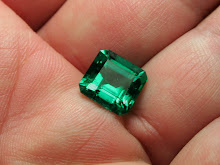Photography is a hobby and an occupation enjoyed by millions of people. And for good reason. There’s something about capturing a moment in time, an image, an action, or even an idea as it occurs and showing it to the world in a way that can’t be duplicated with words alone. It doesn’t matter how many words you use, you cannot convey precisely the same message as a photograph. Photography is perception, background, history, context, and the message all in one visible word. Photography is also art, communication, and many times photography is proof. It can be proof of an existence, an action, a condition, among other things. Photography is versatile but yet often quite absolute.
In gemstone photography, photography is an image and one of proof, although it is a proof that is difficult to achieve. Gemstones and jewelry might possibly be some of the most difficult subjects to photograph. Rarely is a subject so dynamic and its true color so important as it is when trying to record an accurate image of a gemstone or piece of jewelry. It isn’t often we go through pictures in the family photo album or pictures of last summer’s vacation and scrutinize the color and clarity of the photographs. It just isn’t that important. It is when you’re talking about gems. A small tonal difference can create the perception of a stone that would be worth hundreds of dollars less per carat. The reason for the difficulty in capturing a gem’s true essence is usually a combination of lighting and the camera itself. Both of these problem areas can be improved upon with some investment in professional photography and lighting equipment, but rarely are they overcome completely.
I can imagine the online gem shopper who now might be asking themselves, ‘So… how do I know what I’m buying if the photo may not be telling me the whole story?’ It’s understandable to think that way, but luckily the camera seldom makes a bad stone look good. They’re just stuck looking bad. But for good, fine, and decent stones, without fail, stones appear much better in person than what is shown in the photo because a single still image can’t capture the dynamic fire and brilliance of a stone dancing in the light. So it stands to reason, and generally holds true that if you pick a stone you like from a good photograph, you’ll be even more pleased when you see it in person.
Monday, October 22, 2007
Catching Fire
Posted by
www.embassyemeralds.com
at
1:57 PM
![]()
Labels: Emeralds, Gemstones, Photography
Share it! Digg
Digg
 del.icio.us
del.icio.us  Reddit
Reddit
 StumbleUpon
StumbleUpon
 Fark
Fark  Technorati
Technorati
 Netscape
Netscape
 Furl
Furl
Subscribe to:
Post Comments (Atom)



No comments:
Post a Comment